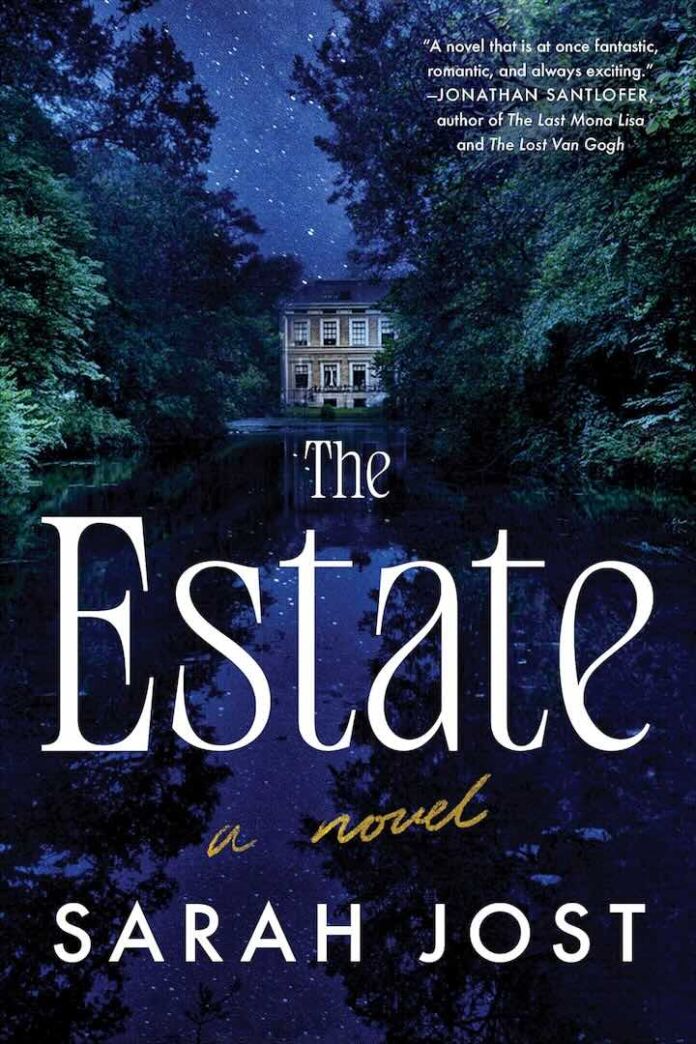Sarah Jost’s sophomore novel, The Estate, is an ambitious blend of speculative fiction, gothic romance, and art history that aims to enchant readers with its unique premise. Following her debut Five First Chances, Jost ventures into darker territory with this story of a woman who can literally step into works of art. While the novel shimmers with potential and offers moments of genuine brilliance, it sometimes struggles under the weight of its own ambitions.
The Art of Storytelling: Plot and Narrative Structure
A Canvas of Intrigue
The story follows Camille Leray, an art historian with an extraordinary gift—the ability to enter artworks and experience the emotions and memories embedded within them. After a professional disaster at Courtenay auction house, she receives an invitation from the mysterious Maxime Foucault to authenticate sculptures at his family estate, D’Arvor, in Brittany. What begins as a chance at redemption evolves into a complex web of deception, obsession, and hidden truths.
Pacing and Development
The narrative unfolds like a carefully crafted piece of art itself, with layers being revealed gradually. The first third of the book is particularly strong, building tension and atmosphere with skillful precision. However, the middle section occasionally meanders, getting lost in the protagonist’s internal struggles and romantic yearnings. The pace picks up significantly in the final third, though some readers might find the resolution slightly rushed.
Character Portraits: Depth and Development
The Protagonist’s Journey
Camille is a fascinatingly flawed protagonist whose desperation for acceptance and validation drives her choices. Her character arc is both compelling and frustrating—while her growth feels authentic, her repeated poor decisions and willful blindness to manipulation can test readers’ patience. Yet, this very imperfection makes her journey more resonant and her eventual awakening more satisfying.
Supporting Cast
The novel’s supporting characters are a mixed palette:
- Maxime Foucault – A charismatic but ultimately problematic love interest whose complexity sometimes veers into contradiction
- Lila Madani – The novel’s most compelling character, whose arc provides the emotional heart of the story
- Lowen – A grounding presence whose relationship with Camille offers interesting possibilities that aren’t fully explored
- The Foucault Family – Well-drawn gothic archetypes that occasionally lack deeper dimension
Themes and Artistic Vision
The Power of Art and Authenticity
Jost explores profound themes about the nature of art, authenticity, and the stories we tell ourselves. The novel asks provocative questions about the value we place on art and the ways in which we can lose ourselves in pursuit of acceptance and prestige.
Female Friendship and Liberation
One of the novel’s strongest elements is its exploration of female friendship and solidarity. The relationship between Camille and Lila evolves beautifully, offering a refreshing counterpoint to the romantic storyline.
Technical Execution
Prose and Style
Jost’s writing is most effective when describing art and the magical experience of entering it. Her prose can be lyrical and evocative:
“The sculpture glows with filigrees of infatuation, devotion, danger. That’s enough for me to know, I reason, staying safely ashore.”
However, some passages feel overwrought, and the internal monologues occasionally become repetitive.
World-Building and Magic System
The novel’s central conceit – the ability to enter artworks – is fascinating but inconsistently developed. The rules governing this power remain somewhat unclear, and its limitations seem to shift according to plot requirements rather than internal logic.
Strengths and Achievements
- Original premise that blends art history with magical realism
- Strong sense of place and atmosphere
- Complex exploration of female relationships
- Thoughtful examination of art’s role in society
- Effective integration of historical elements
Areas for Improvement
- Pacing issues in the middle section
- Some underdeveloped character motivations
- Inconsistent magic system rules
- Occasionally melodramatic romantic elements
- Resolution that feels somewhat rushed
Comparative Context
Fans of Erin Morgenstern’s The Starless Sea or Donna Tartt’s The Secret History will find familiar elements in The Estate, though Sarah Jost’s work is more focused on contemporary themes. The novel also shares DNA with V.E. Schwab’s The Invisible Life of Addie LaRue in its exploration of art and immortality.
Final Assessment
While it doesn’t quite achieve all its lofty ambitions, it offers enough originality and emotional resonance to make it worth reading. The novel’s strengths—its unique premise, atmospheric setting, and exploration of female friendship—outweigh its structural weaknesses and occasional lapses into melodrama.
Ideal Readers
This book will particularly appeal to:
- Art history enthusiasts
- Fans of gothic romance with a contemporary twist
- Readers who enjoy magical realism
- Those interested in female-driven narratives
- People who appreciate complex character studies
Conclusion: A Flawed but Fascinating Canvas
Despite its imperfections, The Estate by Sarah Jost is a noteworthy addition to the speculative fiction landscape. Sarah Jost demonstrates significant growth as a writer, crafting a story that, while not entirely successful in all its aims, offers a unique perspective on art, power, and the prices we pay for our desires. The novel’s flaws are largely those of ambition rather than execution, making it a promising indicator of what Jost might achieve in future works.
Like the artworks it describes, The Estate invites readers to look beneath the surface, finding beauty in its imperfections and truth in its contradictions. While it may not be a masterpiece, it’s certainly a work worth experiencing, particularly for readers who appreciate novels that blur the lines between reality and fantasy while exploring deeply human themes.





